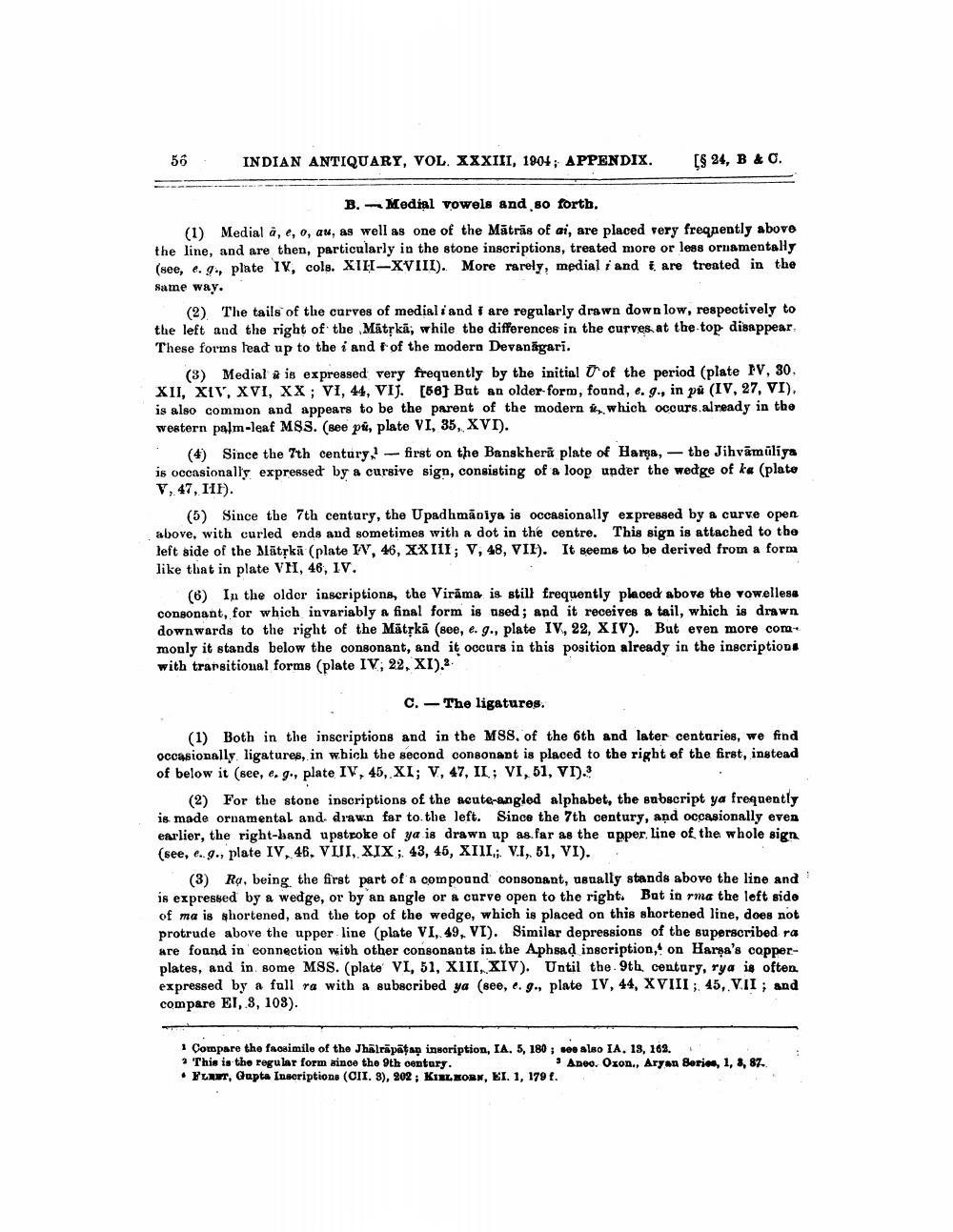________________
56.
INDIAN ANTIQUARY, VOL. XXXIII, 1904; APPENDIX.
($ 24, B&O.
B. Medial vowels and so forth. (1) Medial à, e, o, an, as well as one of the Mātrās of ai, are placed very freqpently above the line, and are then, particularly in the stone inscriptions, treated more or less ornamentally (see, e. 9., plate IX, cols. XIH-XVIII). More rarely, medial i and I are treated in the same way.
(2). The tails of the curves of mediali and i are regularly drawn down low, respectively to the left and the right of the Mātrkā, while the differences in the curves at the top disappear These forms load up to the i and of the modern Devanagari.
(3) Medial * is expressed very frequently by the initial of the period (plate IV, 30. XII, XIV, XVI, XX; VI, 44, VIJ. [56] But an older form, found, e. g., in på (IV, 27, VI). is also common and appears to be the parent of the modern , which occurs already in the western palm-leaf M83. (see pi, plate VI, 35, XVI).
(4) Since the 7th century first on the Banskheri plate of Harya, the Jihvāmūliya is occasionally expressed by a cursive sign, consisting of a loop under the wedge of kæ (plate V, 47, 11F).
(5) Since the 7th century, the Upadhmāniya is occasionally expressed by a curve open above, with curled ends and sometimes with a dot in the centre. This sign is attached to the left side of the Mātrka (plate IV, 46, XXIII; V, 48, VII). It seems to be derived from a form like that in plate VII, 46, IV.
(6) In the older inscriptions, the Virāma is still frequently placed above the vowellesa consonant, for which invariably a final form is used; and it receives a tail, which is drawn downwards to the right of the Mātrkā (see, e.g., plate IV, 22, XIV). But even more com monly it stands below the consonant, and it occurs in this position already in the inscriptions with transitional forms (plate IV, 22, XI).
C. -The ligatures.
(1) Both in the inscriptions and in the MSS. of the 6th and later centuries, we find occasionally ligatures, in which the second consonant is placed to the right of the first, instead of below it (see, e.g., plate IV, 45, XI; V, 47, II : VI, 51, VI).3
(2) For the stone inscriptions of the scute-angled alphabet, the subscript ya frequently is made ornamental and drawn far to the left. Since the 7th century, and occasionally even earlier, the right-hand upstroke of ya is drawn up as far as the upper line of the whole sign (see, e..g., plate IV, 46, VII, XIX ;. 43, 45, XIII; VI, 51, VI). .
(3) Rg, being the first part of a compound consonant, usually stands above the line and is expressed by a wedge, or by an angle or a curve open to the right. But in rma the left side of ma is shortened, and the top of the wedge, which is placed on this shortened line, does not protrude above the upper line (plate VI, 49, VI). Similar depressions of the superscribed ra are found in connection with other consonants in the Aphsad inscription, on Harşa's copperplates, and in some MSS. (plate VI, 51, XIII, XIV). Until the 9th century, rya is often expressed by a full ra with a subscribed ya (see, e. g., plate IV, 44, XVIII; 45, VII ; and compare EI3, 108).
Compare the fnosimile of the Jhālrāpāta inscription, IA, 5, 180; se slao IA. 18, 102. This is the regular form since the 9th century.
• Adeo. Ozon., Aryan Series, 1, 2, 87. • Yarr, Gupta Inscriptions (CII. 3), 202, KIEL KORX, EL. 1, 179 .




